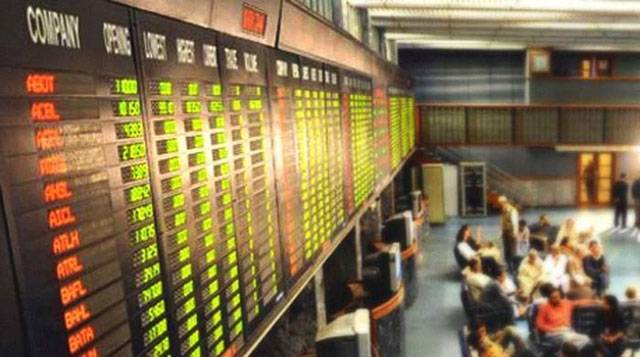Lahore - Positivity returned to the bourse ahead of year-end closing, as investors' looked favourably at the appointment of the new economic team by the government.
Valuations turned compelling, attracting value buying during the week. Local companies and mutual funds turned out to be largest buyers with $8.2 million and $13 million worth of net buying, respectively.
Euphoria was also seen in trading activities with average traded volumes improving to 215 million shares/day (+55 percent WoW) and average traded value increasing to $79 million/day (+53 percent WoW) as most of the buying was observed in heavyweight stocks.
Key sectors outperforming the benchmark KSE-100 index during the week were cements (+8.6 percent WoW) and pharmaceuticals (+3.2 percent WoW). On the other hand, sectors such as fertilizers (+1.3 percent WoW) and E&Ps (+1.6 percent WoW) underperformed the broader index.
The outgoing week marks the end of worst year in terms of market performance since 2008 with KSE-100 index plummeting by 15 percent (US dollar terms: -20 percent) to close at 40,471 pts.
Apart from this, key highlights of the week were: news of impending $6 billion debt repayments in upcoming six months period, tightening government restrictions on the import of furnace oil, OGDCL's discovery at Dhok Hussain, OGRA's recommendations to increase fuel prices by Rs4-10/liter, ABAD fearing $250 million commitments during ABAD expo 2017 to be in jeopardy and Indus Motor (INDU) increasing prices with immediate effect. Experts said that Pakistan’s Benchmark KSE-100 index slumped from being one of the best performing markets in 2016 to 2017’s worst performing market in the world. The market generated below avg. returns in the outgoing calendar year 2017.
Total return KSE-100 Index lost 15 percent (20 percent in $) in 2017 versus last 10-year average return of 24 percent (19 percent in $ terms) and last 20 years average of 27 percent (22 percent in $ terms). This is the worst year for Pak Equities since 2008 when market crashed 58 percent due to price floor.
After strong performance over the past five years (2012-16), with KSE-100 returning 33 percent annually, 2017 turned out to be a tale of two halves. The first half saw a bull run as upgrade to MSCI Emerging Markets (EM) garnered risk-off euphoric sentiments, which rallied the market up to a peak of 52,876 points on May 24, 2017, registering 11 percent growth in first 5 months (Jan-May 24 2017).
Subsequent to the upgrade, sentiments went south drastically as Pakistan’s weight in MSCI EM was lower than expected while foreigners emerged as net sellers instead of buyers. Further, FY18 federal budget was unfavourable for equity markets. The final nail in the coffin was the infamous Panama Leaks, which led to the disqualification of Pakistan’s prime minister.
These factors amalgamated into microscopic scrutiny of our economic shortcomings, with the market falling 23 percent from its peak.
MSCI EM, FM & World indexes returned 34 percent, 28 percent & 20 percent, respectively in 2017. While peer countries such as India (+38 percent), Bangladesh (+18 percent), Vietnam (48 percent), Malaysia (21 percent) & Thailand (25 percent) posted healthy gains.
Due to Pakistan’s gross underperformance, Pakistan is currently trading at a 50 percent discount to MSCI EM vs. 10-Year historical discount of 21 percent. As per Bloomberg, Pakistan Market is trading at P/E 7.9x with a dividend yield of 6.8 percent versus India’s P/E of 19.9x and dividend yield of only 1.9 percent.
Average daily traded volumes at the PSX were down by 16 percent to 236 million shares while average daily traded value was marginally up 3 percent to ($115 million) in 2017.
In the derivative market, traded value in single stock futures stood higher by 43 percent and were Rs4.3 billion/$41.1 million in 2017 as against at Rs3.0 billion/ $29 million in 2016. Albeit volumes declined sharply in 4Q2017 due to political noise.
From a script-wise perspective, the hottest stocks at the PSX in terms of value traded were SNGP, TRG, ENGRO, ATRL & PAEL.
Pakistan Equity markets witnessed 3 Initial Public Offerings (IPOs) during 2017 (excluding Modarabas) raising Rs8.5 billion, compared to 3 IPOs during 2016, which raised Rs4.2 billion. Due to deteriorating investment climate & some regulatory setbacks, 3 IPOs amounting to Rs11 billion were delayed. Foreigners remained net sellers in 2017 for the third consecutive year. They bought shares worth US$4.4bn & sold US$4.9bn resulting in net outflow of US$488mn according to NCCPL data. This remained higher than 2016 net outflow of US$339mn and has taken 3 year outflow to US$1.1bn.
Most of the selling by foreigners was seen in Cement (US$168mn), Banks (US$98mn) and Power (US$51mn) as shown in accompanied table.
This major chunk of selling was absorbed by Mutual Funds who bought US$217mn and Insurance Companies $191mn.






